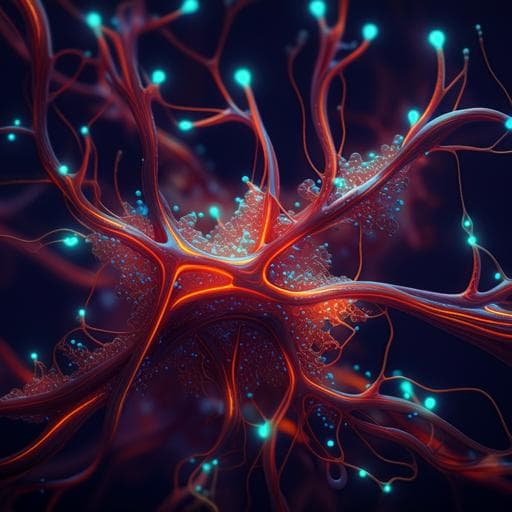
Engineering and Technology
Unravelling the operation of organic artificial neurons for neuromorphic bioelectronics
P. Belleri, J. P. I. Tarrés, et al.
Discover the groundbreaking research by Pietro Belleri, Judith Pons i Tarrés, Iain McCulloch, Paul W. M. Blom, Zsolt M. Kovács-Vajna, Paschalis Gkoupidenis, and Fabrizio Torricelli on organic artificial neurons (OANs) in liquid environments. This innovative work uncovers biorealistic firing properties, excitability, and the potential for biohybrid integration, paving the way for advancements in neuromorphic bioelectronics.
~3 min • Beginner • English
Introduction
The study addresses how organic artificial neurons (OANs) based on organic mixed ionic–electronic conductors operate in liquid environments and how their spiking behavior can be rigorously modeled and designed. Neuromorphic electronics emulate neural building blocks for low-power, bio-interfaced computation. Organic platforms are particularly attractive due to their ionic responsiveness and compatibility with wet environments. Although organic electrochemical transistors (OECTs) have enabled synapses and simple neurons, existing OAN demonstrations have been largely qualitative, lacking quantitative models that incorporate soft-matter physics, electrolytes, ions, and biomembranes. This knowledge gap limits the design and simulation of complex organic neuromorphic systems and biohybrids. The purpose of the work is to combine experiments, physics-based non-linear circuit simulations, and analytical models to unravel the operation of OANs exhibiting S-shaped negative differential resistance (S-NDR), map spiking features to material/device parameters and biochemical conditions, and provide design guidelines for neuromorphic bioelectronics and biohybrid integration.
Literature Review
Prior neuromorphic implementations span metal oxides, ferroelectrics, ferromagnetics, phase-change and 2D materials. Organic OMIEC-based systems uniquely interface with biological ionic carriers and operate in aqueous environments, enabling realistic bio-interactions. Reported organic neurons include: (i) inverter-cascade OECT neurons with ion-dependent firing frequency responsive to Na+ and K+; (ii) OECT-based non-linear neurons exhibiting S-NDR with biorealistic firing, excitability, and neurotransmitter/ion-induced dynamics; (iii) neurons leveraging antiambipolar OMIECs (negative differential transconductance) with varied firing modes and ion/neurotransmitter responsivity, demonstrated to stimulate living models ex-situ; and (iv) biohybrid devices where membrane impedance modulates firing in situ. However, quantitative circuit-level models linking soft-matter physics, ion content, and biomembrane properties to neuron behavior have been lacking, in contrast to inorganic solid-state neurons.
Methodology
The OAN is formed by coupling an organic electrochemical non-linear device (OEND) to a biasing network (R1, CL, VIN). The OEND comprises two OECTs (T1: PEDOT:PSS, depletion-mode p-type; T2: p(g2T-TT), accumulation-mode p-type) and resistors R1 and R2. Device physics modeling of OECTs includes volumetric capacitance (Cv), ion-concentration-dependent threshold voltage (VTH), energetic disorder (γ), and channel-length modulation. The OECT compact model (Verilog-A) is implemented in a circuit simulator (Keysight ADS) to reproduce measured OEND characteristics in voltage and current modes. Analytical expressions for the OEND switching voltages and currents (VON, VOFF, ION, IOFF) are derived, linking them to material/device parameters (e.g., gm, VTH, R1, R2, W, L, t, μ, Cv). Load-line analysis couples the OEND with the RC biasing network to predict spiking conditions and frequency. A closed-form approximate analytical expression for the spiking frequency fspike is derived from integrating the capacitor current over the non-linear I–V loop, and validated against measurements and transient simulations. Parametric sweeps vary VTH1, VTH2, gm1/gm2, Cv1/Cv2, geometry (W,L,t), and R1/R2 to map their impact on fspike, amplitudes, power, and energy per spike. Excitability is probed by injecting small sinusoidal potentials into the electrolyte and tracking phase-locked bursting via modulation of the load-line crossing point. Noise-induced activity is studied by injecting white noise into the electrolyte and simulating stochastic excursions between spiking and silent regimes. Neuromorphic ion sensing is performed by varying extracellular Na+, K+, and Ca2+ concentrations and examining their effect on VTH1 and thus on VON/VOFF and fspike; ion-selective behavior is achieved by integrating ionophore-based selective membranes (ISM) at T1 to modulate VTH1 selectively to target ions. Biointerfacing is demonstrated by inserting a biological cellular barrier between the gate and channel electrolyte of T1, modeled as RM||CM separating apical and basal compartments with electrolyte resistances; AC analysis computes the transfer function across the barrier to explain damping of oscillations in intact membranes and restoration upon tight-junction disruption with toxins. Device fabrication details include photolithographic Au electrodes on glass, parylene C passivation and patterning, PEDOT:PSS and p(g2T-TT) film deposition, and Ag/AgCl gate use. Numerical simulations (DC, AC, transient, frequency) are conducted in ADS; data analysis is done in MATLAB.
Key Findings
- The OEND exhibits a hysteretic IOEND(VOEND) in voltage mode and a non-hysteretic S-shaped negative differential resistance VOEND(IOEND) in current mode. Analytical switching conditions were derived: VON and VOFF depend on VTH1, VTH2, gm1, gm2, R1, R2, and geometry; ION and IOFF scale with VTH and R1.
- Spiking arises when the load line intersects the OEND characteristic within the negative resistance region; the spiking region is bounded by UON=(VON,ION) and UOFF=(VOFF,IOFF). A unique intersection requires RD (negative resistance magnitude) < R1.
- An analytical model for fspike, validated by transient simulations and measurements, captures dependence on R1, CL and material/device parameters via VON, VOFF, VIN and IOEND. Measured fspike versus CL matches simulations and analytics.
- Design knobs for frequency: fspike increases with decreasing VTH1, gm1, Cv1, and R2, and with increasing VTH2 (opposite trend), while being nearly insensitive to gm2 and R1 over the studied range. Minimizing Cv2 and T2 geometry (W2, L2, t2) enables higher fspike and lower required CL.
- Frequency–energy trade-offs: higher fspike reduces energy per spike (Espike = POAN/fspike). Minimum Espike achieved ≈ 1 × 10^-11 J by minimizing Cv2 (with other parameters nominal). Power increases with fspike, while amplitude decreases.
- Excitability is tunable: excitation thresholds range from microvolts to hundreds of millivolts by adjusting gm1/gm2, Cv1/Cv2, R1/R2, and VTH1/VTH2. Phase-locked bursting is obtained with sinusoidal electrolyte signals as low as a few microvolts.
- Noise-induced dynamics: with white-noise injection, tonic firing persists for small noise (e.g., Vpp ≈ 25 mV); increased noise (e.g., 50–150 mV) stochastically pushes the operating point into/out of the spiking region, yielding interrupted spikes and random spike packets. Designs can exploit noise to induce spiking from an initially silent state.
- Neuromorphic ion sensing: extracellular ion concentration shifts OECT VTH1 (via gate/electrolyte and Donnan potentials), modulating VON/VOFF and hence fspike. Measured/simulated fspike increases with Na+ in the physiological range (e.g., ~20–50 Hz modulation). Frequency modulation sensitivities: ≈ 38.95 Hz/dec for monovalent (Na+, K+) and ≈ 26.69 Hz/dec for divalent (Ca2+). Frequency encoding is robust to added noise, unlike conventional OECT current readouts.
- Ion selectivity via ISM at T1 yields ion-specific excitability and spiking: K+-selective OAN spikes in KCl and is silent in Na+, and vice versa for Na+-selective configurations.
- Biointerfacing with cellular barriers: inserting an intact barrier damps and suppresses oscillations (~2 s decay), while barrier disruption (e.g., toxins opening tight junctions) restores spiking. AC analysis shows attenuation across the barrier in the 10–150 Hz band (|HAB| ≈ 0.2 dB), with RM strongly governing damping; CM broadens the affected frequency range. The damping time constant τ reports on tight-junction status.
Discussion
The work quantitatively explains how organic artificial neurons operate by linking their spiking behavior to the physics of OMIEC-based OECTs and the electrolyte environment. By deriving analytical expressions for switching points (VON, VOFF, ION, IOFF) and a computationally efficient estimate of fspike, the study bridges device/material parameters with neuronal metrics (frequency, amplitude, excitability, energy). This addresses the central challenge of moving from qualitative demonstrations to predictive, scalable design of OANs. The results demonstrate robust frequency-encoded sensing of biologically relevant ions and resilience against noise, highlighting advantages over conventional current-based readouts. Ion-selective membranes provide biologically meaningful selectivity, enabling ion-specific excitability and spiking. Biohybrid integration with cellular barriers shows how membrane impedance modulates excitability and can be read out via spike damping, suggesting in situ monitoring of barrier states. Collectively, the findings enable rational engineering of OANs for neuromorphic bioelectronics, wetware neural networks, and hybrid interfaces, providing guidelines on materials (e.g., minimizing Cv2, tuning VTH), device geometry, and circuit biases to target desired spiking regimes and energy-performance trade-offs.
Conclusion
This study unravels the operation of organic electrochemical artificial neurons by integrating experiments, physics-based non-linear simulations, and analytical modeling. It establishes direct mappings between material/device parameters, electrolyte composition, and neuronal metrics such as fspike, excitability thresholds, power, and energy per spike. The framework reproduces and rationalizes biorealistic behaviors including phase-locked bursting, noise-induced firing, ion-selective spiking, and biohybrid operation with cellular barriers. The analytical tools and design maps offer transferable guidelines for engineering OANs, advancing neuromorphic bioelectronics, in-liquid neural networks, and biointerfacing. Future work should focus on further reducing energy per spike toward biological levels, optimizing OMIEC materials (e.g., lowering volumetric capacitance and tailoring mobility), integrating larger-scale OAN networks, and expanding biohybrid modalities for closed-loop stimulation and sensing.
Limitations
Energy per spike remains higher than in biological neurons; reducing it requires improved materials and device optimization (e.g., lower volumetric capacitance, optimized geometry). The demonstrated frequency range and amplitudes depend on specific OMIEC choices and geometries; generalization to all materials may require re-parameterization. Biohybrid modeling indicates that equivalent circuit complexity can vary with cell type and barrier properties, potentially affecting transfer characteristics. While the models include key soft-matter and electrolyte effects, further validation across diverse ionic species, concentrations, and dynamic biological signals will strengthen generalizability.
Related Publications
Explore these studies to deepen your understanding of the subject.







